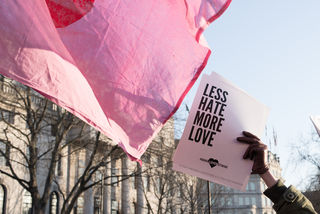
Recently, several members of a group calling itself “Respect the Flag” were sentenced to prison for terrorizing guests at the birthday party of an 8-year-old African-American girl in Georgia. Pointing a shotgun, they yelled racial slurs and death threats at guests, including children.
It wasn’t an isolated incident. According to a recent study, there are at least 917 organized hate groups in the United States. The study, based on data collected by the Southern Poverty Law Center (SPLC) and presented in their annual census of hate groups, looked at the presence of hate groups on Twitter. SPLC found that the number of likes and comments on hate group accounts grew by 900 percent in the last two years.
Why do we hate? The reasons are complex, but following are some of the factors that may play a role in helping us understand hate and, hopefully, work toward change.
Fear of “The Other”
According to A.J. Marsden, assistant professor of psychology and human services at Beacon College in Leesburg, Florida, one reason we hate is because we fear things that are different from us.
Behavioral researcher Patrick Wanis, cites the in-group out-group theory, which posits that when we feel threatened by perceived outsiders, we instinctively turn toward our in-group—those with whom we identify—as a survival mechanism. Wanis explains, “Hatred is driven by two key emotions of love and aggression: One love for the in-group—the group that is favored; and two, aggression for the out-group—the group that has been deemed as being different, dangerous, and a threat to the in-group.”
Fear of Ourselves
According to Washington, D.C., clinical psychologist Dana Harron, the things people hate about others are the things that they fear within themselves. She suggests thinking about the targeted group or person as a movie screen onto which we project unwanted parts of the self. The idea is, “I'm not terrible; you are.”
This phenomenon is known as projection, a term coined by Freud to describe our tendency to reject what we don’t like about ourselves. Psychologist Brad Reedy further describes projection as our need to be good, which causes us to project "badness" outward and attack it:
"We developed this method to survive, for any 'badness' in us put us at risk for being rejected and alone. So we repressed the things that we thought were bad (what others told us or suggested to us that was unlovable and morally reprehensible) — and we employ hate and judgment towards others. We think that is how one rids oneself of undesirable traits, but this method only perpetuates repression which leads to many mental health issues.
Lack of Self-compassion
The antidote to hate is compassion — for others as well as ourselves. Self-compassion means that we accept the whole self. “If we find part of ourselves unacceptable, we tend to attack others in order to defend against the threat,” says Reedy. “If we are okay with ourselves, we see others’ behaviors as ‘about them’ and can respond with compassion. If I kept hate in my heart for [another], I would have to hate myself as well. It is only when we learn to hold ourselves with compassion that we may be able to demonstrate it toward others.”
It fills a void
Psychologist Bernard Golden, author of Overcoming Destructive Anger: Strategies That Work, believes that when hate involves participation in a group, it may help foster a sense of connection and camaraderie that fills a void in one’s identity. He describes hatred of individuals or groups as a way of distracting oneself from the more challenging and anxiety-provoking task of creating one’s own identity:
"Acts of hate are attempts to distract oneself from feelings such as helplessness, powerlessness, injustice, inadequacy and shame. Hate is grounded in some sense of perceived threat. It is an attitude that can give rise to hostility and aggression toward individuals or groups. Like much of anger, it is a reaction to and distraction from some form of inner pain. The individual consumed by hate may believe that the only way to regain some sense of power over his or her pain is to preemptively strike out at others. In this context, each moment of hate is a temporary reprieve from inner suffering."
Societal and Cultural Factors
The answer to why we hate, according to Silvia Dutchevici, LCSW, president and founder of the Critical Therapy Center, lies not only in our psychological makeup or family history, but also in our cultural and political history. “We live in a war culture that promotes violence, in which competition is a way of life,” she says. “We fear connecting because it requires us to reveal something about ourselves. We are taught to hate the enemy — meaning anyone different than us — which leaves little room for vulnerability and an exploration of hate through empathic discourse and understanding. In our current society, one is more ready to fight than to resolve conflict. Peace is seldom the option.”
What Can We Do?
Hatred has to be learned, Golden says: “We are all born with the capacity for aggression as well as compassion. Which tendencies we embrace requires mindful choice by individuals, families, communities and our culture in general. The key to overcoming hate is education: at home, in schools, and in the community.”
According to Dutchevici, facing the fear of being vulnerable and utterly human is what allows us to connect, to feel, and ultimately, to love. She suggests creating “cracks in the system.” These cracks can be as simple as connecting to your neighbor, talking with a friend, starting a protest, or even going to therapy and connecting with an ‘Other.’ It is through these acts that one can understand hate and love.”
In other words, compassion towards others is the true context that heals.
The SPLC encourages anyone who witnesses a hate crime — including hateful harassment or intimidation — to first report the incident to local authorities, then go to SPLC’s #ReportHate intake page to continue the effort to track hate in the country.




